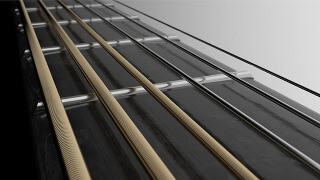GUITAR STRINGS
GUITAR STRINGS. WHAT KIND DO I NEED? HOW TO STRETCH THEM ON A GUITAR? HOW TO TAKE CARE ABOUT THEM? WHAT ARE THE PRICES?
We can divide them into two basic groups: Nylon and metal.
Nylon - It belongs exclusively to the classic (Spanish) or flamenco guitar. The three lower melodic strings are made of special nylon fiber. Three bass strings are made of several nylon fibers that are wrapped with different types of metal wire. The properties of melodic strings without winding improve with age - the nylon is strengthened under tension and the strings therefore get brighter sound and more loudness. They are very stable and hold well.

Depending on their hardness, we divide them into soft, medium and hard.
Nylon strings with low, medium, high and extra-thick thickness are sold. Some nylon strings are tailored to the special sound effect we want to achieve. They can have, for example, enhanced "heights" to highlight high tones or "bass" to highlight deep tones. The special category includes flamenco strings, which are characterized by lower tension and a characteristic creeping effect.
I do not recommend puting metal strings on the Spanish guitar. I understand this for older types of guitars, which can not be clearly classified as Spanish or jumbo guitars. These guitars were often designed for metal strings and were also sold with them (at least, as far as I know, repair me). If you are still decided to do this (often the reason is to achieve a more pronounced sound, which can be partly achieved with "nylon" by knowing the right strike on the strings), do not use strings with a diameter "e" of strings higher than 0.10 ("tens"), otherwise it is very likely that you will begin to kick off the bridge and bend your neck and destroy the guitar!!!
Metal - Generally we distinguish according to the diameter of the "e" (lower) strings:
Diameter:
0.08 - electric guitars (do not use for acoustic guitar!)
0.09 and 0.10 - soft, easy to squeeze, but they do not have too much strong sound
1.1 and 1.2 - harder, but the sound is stronger, better
In general, the harder the strings you choose, the higher the sound quality (if the strings are good), but also the more difficult strings to squeeze.
WHAT DO I NEED?
Firstly, it depends on the type of your guitar:
Spanish guitar - Nylon strings (may be metallic, but I don't recommend it for the above reasons). Nylon strings do not matter so much on hardness (all are relatively easy to press), like the style of play that we prefer. We are therefore mainly guided by the sound effects that strings offer - see Nylon strings.
Different guitars may suit different types of strings, and it is not possible to say with precision which strings will suit one or another guitar. So often we have no choice, but to try the "trial-end-error" method at first and try all sorts of strings until we find the ones that suit us.
According to the musical activity I want to apply - nylon strings are used mainly in classical music, flamenco, brazilian music and jazz.
Jumbo Guitar - Metal Strings. Here depends mainly on the diameter (hardness) of the strings, see Metal Strings and of course also on the style of your music - if you play jazz, you will probably need a sharper and more pronounced tone and therefore choose harder strings. It also depends on whether you are playing your fingers (rather soft strings) or pick (they may be harder). For beginners I recommend soft strings 0.10 or 0.11.
Electric guitar - The surface of the electric guitar strings is made of nickel and iron alloy, nickel-plated steel, stainless steel and other metals or alloys. Different materials used on the surface of the string provide a different tone and also a slightly different level of output when amplified.
How to stretch guitar strings
Before pulling the strings onto the guitar, it is necessary to properly remove the dirt, which could quickly damage the strings. If we decide to make some adjustments or repairs to the guitar, it is advisable to do so before the new strings are stretched, so that we do not have to remove and stretch them repeatedly and thus depreciate them. Replace strings with washed hands! For the description of guitar care, please visit the Guitar Care section.
Nylon strings - see instructional video.
Some types of nylon have a few centimeters of loose wires at one end. This end does not belong to the bridge!!!
What will we need?
Splitting pliers, string reel and tuning.

String reel
None of these utilities is a necessity, but it can make it easier for us to work, depending on the situation. I will try to explain why:
Splitting Pliers - Used to shorten the string if it is too long. Also, after the exchange, we can pinch the possible protruding ends of strings in bridges that touch the front plate and cause unpleasant "buzzing" at play. Especially for metal strings it is advisable to pinch the protruding ends at the heads of the guitar. We avoid the painful insertion of the string into your finger or eye!
String Reel - Allows strings to wind evenly and quickly.
Tuner - Some good-hearted guitarists already remember the pitch of the strings and without the tuning (but they must have silence, which is also not always possible). Then it is also possible to use the other tuned tool to tune in. The tuner may not always be 100% reliable (may be poor or poorly tuned due to faulty batteries). For more information, see Tuning Guitar and Guitar Tuners.
Metal strings (acoustic guitar) - see instructional video.
Metal strings (electric guitar) - see instructional video.





